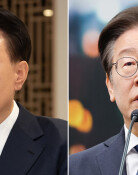Fukushima to release radioactive wastewater for next 30 years
Fukushima to release radioactive wastewater for next 30 years
Posted August. 25, 2023 08:34,
Updated August. 25, 2023 08:34

The Tokyo Electric Power Company (TEPCO) in charge of the Fukushima Daiichi Nuclear Power Plant started discharging treated radioactive water stored at the tsunami-stricken facilities into the sea at 1:03 p.m. on Wednesday. Japan will run the Advanced Liquid Processing System (ALPS) to treat 1.34 million tons of wastewater before releasing it into the Pacific Ocean. The discharge of radioactive wastewater was executed 12 years and five months after the Tōhoku earthquake and tsunami devastated the Fukushima nuclear power stations in March 2011.
The TEPCO ignited transport pumps installed inside the power plants to release wastewater into the sea 1 kilometer away from the facilities. It explained that the discharged wastewater has 43 to 63 Bq of tritium per liter, adding that it is way lower than its independently defined range of 1,500 Bq per liter.
It confirmed that 200 to 210 tons of wastewater was released into the sea. For the next 17 days, around 7,800 tons of radioactive water will flow into the sea. Furthermore, within this year, 31,200 tons of treated wastewater stored in 30 tanks are expected to be discharged – accounting for 2.3 percent of the total tonnage stored in the Daiichi facilities. The Japanese government plans to discharge all the stored wastewater for the next 30 years and close down the nuclear power plant by 2051. However, Japanese news media outlets point out that the government’s plan is not feasible because wastewater is continuously generated as underground water flows into the devastated nuclear reactors.
Inspectors of the International Atomic Energy Agency (IAEA), who were stationed on the spot with TEPCO staffers, checked if the discharge met IAEA safety standards and then released data on concentration levels of radioactive matters contained in wastewater. “IAEA experts are there on the ground to serve as the eyes of the international community and ensure that the discharge is being carried out as planned consistent with IAEA safety standards,” IAEA Director General Rafael Grossi said in a statement issued right after the first-day discharge was executed.
yea@donga.com







